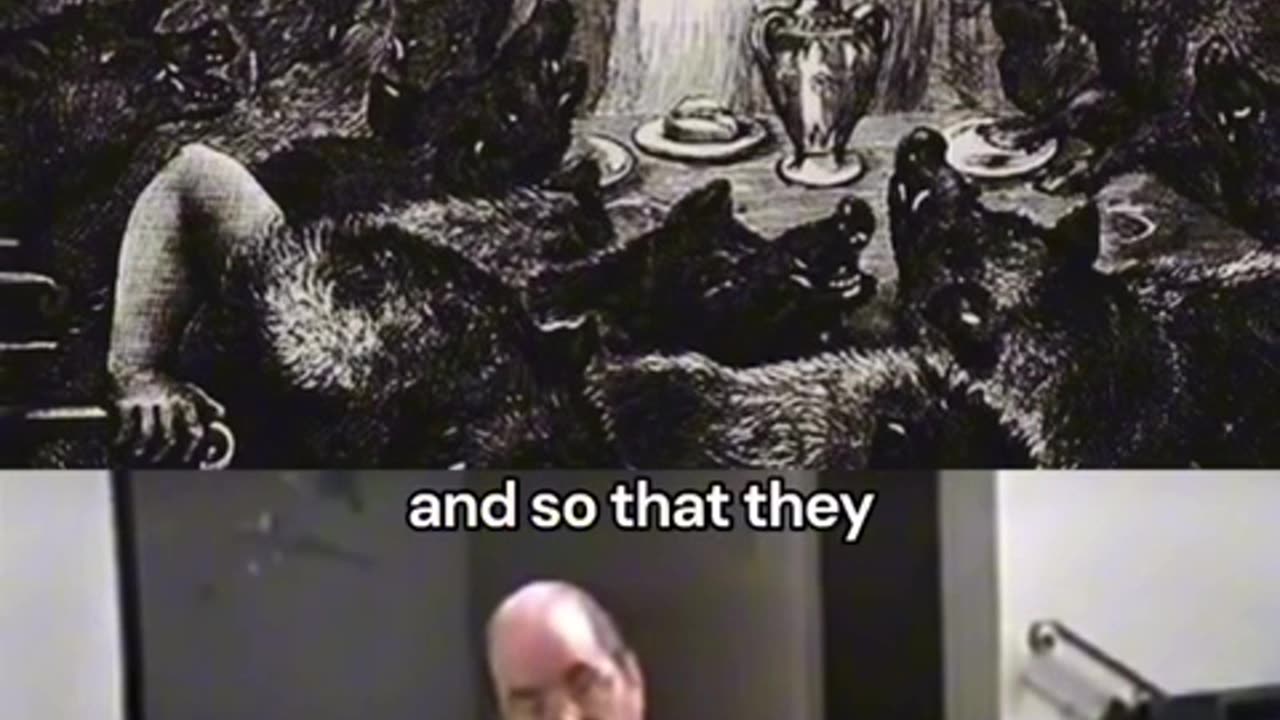Premium Only Content

Cersei’s Legacy: The Linguistic and Cultural Evolution of the Church
### **I. Introduction: The Cultural and Linguistic Evolution of Sacred Spaces**
#### **A. Defining Sacred Spaces Across Cultures**
Sacred spaces have been integral to human societies across time and geography, serving as physical manifestations of the divine and spiritual within the material world. These spaces, whether temples, shrines, groves, or churches, are sanctified areas where the boundaries between the mortal and the divine are believed to thin, allowing for communion with higher powers. They are not just buildings or locations; they are the very heart of spiritual life, places where the sacred and the mundane intersect.
In many ancient cultures, sacred spaces were seen as microcosms of the universe, reflecting the cosmos's order and harmony within their architecture and layout. For example, the **Ziggurats of Mesopotamia**, towering temple complexes, were constructed to mirror the structure of the cosmos, with each ascending level representing a different realm of existence. Similarly, the **Hindu temples of India** are designed according to Vastu Shastra principles, aligning with cosmic forces to channel divine energy into the physical space. These structures are often oriented in specific ways to harness the spiritual energy of the earth and cosmos, creating a space that is both physically and metaphysically potent.
In **Indigenous traditions**, sacred spaces are often found in natural settings, such as mountains, rivers, or groves, where the landscape itself is imbued with spiritual significance. For example, the Lakota people consider the Black Hills (Paha Sapa) in South Dakota as the center of their universe, a place of profound spiritual importance where they connect with the divine. In these contexts, the land itself is sacred, and human-made structures are secondary or even unnecessary.
In contrast, within **Abrahamic religions**, sacred spaces are often constructed as temples or churches, physical structures where communities gather to worship and experience the divine collectively. The **Jewish Temple in Jerusalem**, the **Christian churches** scattered across the globe, and the **Islamic mosques**, such as the Kaaba in Mecca, are central to the religious lives of their adherents. These spaces are consecrated, filled with symbolic architecture, and often believed to be the dwelling places of the divine or the points of closest contact between the divine and human worlds.
The word "church," specifically within the context of English-speaking societies, carries deep cultural and religious significance as a sacred space. Derived from the Old English word "cirice," which in turn comes from the Greek "kyriakon," meaning "of the Lord," the term "church" historically refers to a building where Christians gather to worship. However, beyond its physical definition, "church" also represents the community of believers and the body of Christ in Christian theology. This dual meaning underscores the concept of sacred spaces not only as physical locations but also as embodiments of collective spiritual identity and experience.
Thus, sacred spaces, whether in the form of natural sites or constructed temples, play a crucial role in human societies. They are places where the sacred is invoked, celebrated, and experienced, serving as focal points for religious practice, cultural identity, and communal gathering. The concept of the "church" within this broader context highlights its role as both a physical structure and a symbol of the spiritual and communal life of its people.
### **II. Etymology of the Word "Church"**
#### **A. Origins and Linguistic Evolution**
The word "church" in the English language has a complex etymology that traces back through various cultures and languages, reflecting both religious and linguistic evolution over centuries. The modern English word "church" is derived from the Old English word "cirice" or "circe," which itself evolved from the Proto-Germanic "*kirika*". However, the roots of this term extend much further back into history, crossing into the realms of Roman and Greek civilizations.
The Old English "cirice" was borrowed from the West Germanic "*kirika*," which in turn comes from the Greek term "κυριακόν" (kyriakon), meaning "of the Lord." This term was typically used to describe the house of worship, or the Lord's house, where Christian communities gathered to practice their faith. "Kyriakon" is derived from "κύριος" (kyrios), meaning "lord" or "master," directly referring to Jesus Christ in Christian theology. Thus, the term "church" originally carried connotations of a space dedicated to the worship of Christ, the Lord.
Delving deeper into the etymology, the Greek "kyriakon" itself can be connected to earlier influences, particularly through its phonetic and conceptual evolution. The word "Kirk" in Scottish, which also means "church," has a direct linguistic lineage from this Greek origin. This word "Kirk" is still widely used in Scotland to refer to church buildings and the national church of Scotland, highlighting its enduring legacy.
Interestingly, the etymological journey of "church" takes a mythological turn when we trace the influences of Roman and Greek deities, particularly the goddess Cersei (also spelled Circe). In Greek mythology, Cersei was a powerful enchantress known for her ability to transform men into animals using potions and spells. Her name has often been linked etymologically to words like "circle" and "circus," which relate to places of gathering or ritual, though these connections are more interpretative than direct.
Cersei’s role as a manipulator and transformer of reality can be seen metaphorically reflected in how religious institutions, particularly the church, have historically functioned to shape and guide the spiritual and moral direction of communities. The transformation of the word from Cersei to "church" (through a series of linguistic evolutions and cultural adaptations) could be interpreted as symbolic of the church's role in transforming the spiritual lives of its adherents.
This linguistic evolution from a goddess associated with magic and transformation to a term denoting the Christian house of worship illustrates not only the shifts in religious belief systems but also how language evolves to reflect changing societal structures. The Christian church, as a dominant institution in Western history, absorbed and repurposed elements from pre-existing cultures and languages, often reinterpreting them within a Christian framework.
#### **B. Cross-Cultural Comparisons**
When we examine the concept of "church" across different languages and cultures, we find that every major religion has its own term for its sacred spaces, each carrying unique connotations and reflecting specific religious, cultural, and societal contexts.
For instance, in **Judaism**, the term "synagogue" comes from the Greek "synagogē," meaning a place of assembly. The synagogue serves as a place of worship, study, and community gathering. Unlike the term "church," which has strong connotations of a hierarchical institution, "synagogue" emphasizes the communal aspect of Jewish religious life.
In **Islam**, the word "mosque" is derived from the Arabic "masjid," meaning "place of prostration." The mosque is not only a place for communal prayers but also a center for learning and community activities. The word "masjid" underscores the act of worship and submission to Allah, the central aspect of Islamic practice.
Similarly, in **Hinduism**, the term "mandir" or "temple" is used to describe places of worship dedicated to various deities. These temples are often intricately designed and serve as a nexus for religious rituals, community festivals, and spiritual education. The word "mandir" comes from the Sanskrit root "mandira," meaning a house or dwelling, signifying the abode of the deity.
Each of these terms—church, synagogue, mosque, and temple—reflects not just a physical space but also encapsulates the essence of the spiritual practices, values, and community life of the religions they represent. The evolution of these words highlights the universal human need for sacred spaces, while their differences reveal how these spaces are culturally framed and understood.
### **III. Mythological Connections: The Tale of Cersei**
#### **A. The Mythological Roots of Cersei**
Cersei, in Greek mythology, is a powerful sorceress known for her ability to transform humans into animals. She resides on the island of Aeaea, where she uses her knowledge of herbs and potions to exert control over those who come to her. The myth of Cersei is rich with themes of transformation, dominance, and the manipulation of reality—elements that have resonated deeply in various cultural and religious narratives.
In the context of the word "church," the connection to Cersei is not merely linguistic but symbolic. The evolution of the term "church" from the Greek "Cersei" reflects a deeper cultural inheritance of the themes she embodies. Cersei's ability to change the form and consciousness of individuals can be seen as a metaphor for the transformative power of religious institutions. Just as Cersei transformed her visitors, the church, in its historical context, has often been a place where individuals undergo spiritual and moral transformations. This metaphor extends to the control and influence that religious institutions have historically wielded over communities, shaping the collective consciousness and guiding moral and ethical standards.
The figure of Cersei also touches on the idea of the sacred space as a place of mystery and power. In many ancient cultures, temples and sacred spaces were seen as places where the divine or supernatural forces could be accessed, much like Cersei's island. These were places where reality could be altered, where the ordinary became extraordinary, and where the boundaries between the human and the divine could blur.
#### **B. Broader Esoteric Symbolism**
Expanding beyond Cersei, the symbolic impact of other mythological and esoteric figures such as Hecate, Isis, and Inanna further enriches the understanding of how religious institutions, particularly the concept of the church, have been shaped. Hecate, often associated with magic, witchcraft, and the crossroads, represents the liminal space between the mundane and the spiritual. Her influence is seen in the way churches and other religious institutions serve as gateways between the earthly and the divine, offering guidance at the crossroads of life and death, morality and sin, the material and the spiritual.
Isis, the Egyptian goddess of magic, motherhood, and fertility, is another figure whose influence extends to the concept of the church. Isis was revered for her ability to restore life, symbolized in the myth of the resurrection of Osiris. This theme of death and rebirth is central to many religious institutions, including Christianity, where the resurrection of Christ is a cornerstone. The church, like the temples of Isis, serves as a place where the mysteries of life and death are contemplated, where the faithful seek transformation and renewal.
Inanna, the Sumerian goddess of love, war, and fertility, embodies the duality of creation and destruction, a theme that resonates with the dual role of religious institutions as both nurturers of the soul and enforcers of moral order. Inanna's descent into the underworld and her subsequent return is another powerful symbol of transformation, echoing the spiritual journeys facilitated by religious institutions.
These mythological figures and the themes they represent—transformation, control, life, death, and rebirth—are deeply embedded in the concept of the church. They highlight the church's role not just as a physical space, but as a symbolic structure where the divine and the human, the sacred and the profane, intersect. By tracing the word "church" back to these mythological roots, we gain a deeper understanding of how religious institutions have been shaped by ancient symbols and narratives, and how they continue to influence the spiritual and cultural landscape today.
### **IV. The Church as a Financial and Power Institution**
#### **A. Historical Role of the Church in Power Structures**
The church, particularly the Roman Catholic Church, has played a pivotal role in shaping social, financial, and political structures throughout history. From the fall of the Roman Empire through the Middle Ages and into the modern era, the church has been a central institution in European life, wielding enormous influence over kings, emperors, and common people alike. The Papacy, in particular, established itself as a powerful political entity, often rivaling and even surpassing secular rulers in terms of influence and control.
During the Middle Ages, the church amassed significant wealth through tithes, land ownership, and donations from the faithful, becoming one of the largest landowners in Europe. This economic power allowed the church to exert considerable influence over secular governments, often dictating terms to kings and emperors. The church's ability to excommunicate rulers or place entire nations under interdict gave it leverage in political matters, ensuring that its interests were protected and advanced.
Moreover, the church played a critical role in the administration of justice, education, and welfare. Monasteries and cathedral schools were the primary centers of learning, preserving knowledge through the so-called "Dark Ages" and laying the foundations for the university system in Europe. The church's involvement in these areas further cemented its position as a central authority in both spiritual and temporal matters.
The Roman Catholic Church's reach extended far beyond Europe. Through missionary work, the church spread Christianity to the Americas, Africa, and Asia, often working hand-in-hand with colonial powers. This global influence not only expanded the church's religious mission but also its political and economic power, as it played a key role in the cultural and spiritual colonization of indigenous peoples.
#### **B. Sacred Geometry and Architecture**
The architecture of churches, especially cathedrals, is rich with sacred geometry, reflecting the belief that certain geometric shapes and proportions resonate with cosmic or divine order. Sacred geometry involves the use of specific ratios and patterns that are considered fundamental to the universe's structure, mirroring the harmony and perfection of creation itself.
One of the most significant geometric patterns found in church architecture is the Flower of Life, a symbol that is said to contain the blueprint of the universe. This pattern, consisting of overlapping circles, is believed to represent the interconnectedness of all life and the unity of creation. While not always overtly present, the principles of the Flower of Life can be seen in the intricate designs of rose windows, floor mosaics, and even the overall layout of certain churches.
The golden ratio, or divine proportion, is another key element in sacred architecture. This mathematical ratio, approximately 1.618, is considered aesthetically pleasing and is found in nature, from the spirals of shells to the branching of trees. In churches, the golden ratio is often used in the proportions of buildings, including the relationship between the height and width of the nave, the layout of facades, and the dimensions of altars and pulpits. This adherence to the golden ratio was believed to create a sense of harmony and balance, making the church a reflection of divine beauty.
Churches were often aligned with celestial bodies, particularly during the construction of cathedrals in the Gothic period. This alignment was intended to connect the earthly with the heavenly, emphasizing the church's role as a bridge between the material world and the divine. For example, many cathedrals are oriented so that the nave aligns with the sunrise on significant feast days, such as Easter, reinforcing the connection between the structure and the cosmos.
#### **C. Influence of Esoteric Orders**
Esoteric orders such as the Freemasons and the Knights Templar have had a profound influence on church architecture, doctrine, and rituals, embedding hidden symbols and teachings within the very fabric of church structures. These groups, often operating in secrecy, were repositories of ancient knowledge and mystical traditions that they sought to preserve and transmit through the symbols and rituals of the church.
The Freemasons, for example, are widely believed to have played a significant role in the construction of many medieval cathedrals. As skilled craftsmen and builders, Freemasons incorporated their symbolic knowledge into the design and ornamentation of these sacred spaces. Masonic symbols, such as the compass and square, the all-seeing eye, and the pillars of Jachin and Boaz, can be found in various forms within church architecture, from the carvings on pillars to the arrangement of spaces within the building.
The Knights Templar, a medieval Christian military order, were also deeply involved in the construction and financing of churches, particularly during the Crusades. The Templars are associated with the preservation and dissemination of esoteric knowledge, much of which is believed to be encoded within the churches they built or funded. Their use of symbolism, such as the cross pattée and the depiction of the Holy Grail, is thought to convey deeper spiritual truths related to the quest for divine knowledge and the protection of sacred mysteries.
These esoteric orders viewed the church as more than just a place of worship; they saw it as a sacred vessel, a microcosm of the universe where the initiated could access higher levels of spiritual understanding. The careful incorporation of sacred geometry, symbolism, and architectural alignment within churches reflects this esoteric perspective, transforming these structures into living embodiments of spiritual principles and cosmic laws.
Through these elements, the church not only served as a center of power and influence but also as a repository of hidden wisdom, accessible to those who possessed the knowledge to interpret its symbols and architecture. The legacy of these esoteric orders continues to intrigue and inspire, suggesting that the church, in its physical and spiritual dimensions, holds secrets that have yet to be fully understood.
### **V. Linguistic and Cultural Implications**
#### **A. Shifts in Meaning Over Time**
The word "church" has undergone significant shifts in meaning, particularly during pivotal historical periods such as the Protestant Reformation and the Enlightenment. These shifts reflect broader changes in societal structures, religious practices, and cultural norms.
During the Protestant Reformation, the word "church" began to be redefined in response to the growing dissatisfaction with the Roman Catholic Church's authority and practices. Reformers like Martin Luther and John Calvin challenged the centralized power of the Catholic Church, advocating for a return to what they perceived as the true essence of Christianity—faith and the Scriptures. This period saw a shift from viewing the church as a hierarchical institution to understanding it more as a community of believers. The idea of the "priesthood of all believers" emerged, where the church was not just a physical building or an ecclesiastical structure but a spiritual fellowship of individuals united by faith. This redefinition of "church" influenced the development of various Protestant denominations, each with its own interpretation of what it means to be a part of the "church."
The Enlightenment further transformed the meaning of the word "church," as this period emphasized reason, individualism, and skepticism of traditional authority, including religious institutions. The church, once seen as the unquestionable authority on moral and spiritual matters, began to be viewed through a more critical lens. The rise of secularism and the separation of church and state during this time led to a broader redefinition of the church’s role in society. The word "church" began to carry connotations of tradition and conservatism, sometimes being associated with resistance to progress and change. In response, many religious communities sought to modernize, leading to new interpretations of what it means to belong to a church in a rapidly changing world.
These shifts in meaning illustrate how the concept of "church" is deeply tied to the historical and cultural contexts in which it is used. The evolution of the word reflects ongoing tensions between tradition and innovation, authority and individualism, and the sacred and the secular. As society continues to evolve, the meaning of "church" is likely to undergo further transformations, influenced by new religious, cultural, and social dynamics.
#### **B. Psychological and Emotional Impact**
The word "church" and similar religious terms carry significant psychological and emotional weight, influencing individuals and communities in profound ways. This impact can be analyzed through the lenses of neurotheology and the psychology of religion, both of which explore how religious language and concepts affect the human mind and behavior.
Neurotheology, a field that examines the relationship between the brain and religious experiences, suggests that religious language can activate specific neural pathways associated with feelings of awe, reverence, and transcendence. The word "church" itself may evoke a sense of belonging, security, and connection to something greater than oneself. For many, the church is a sanctuary, a place where they can find comfort and guidance in times of need. This emotional attachment is often reinforced by early life experiences, such as attending services with family or participating in religious rituals, which create strong neural associations between the word "church" and feelings of safety and community.
On the other hand, the word "church" can also evoke negative emotions, particularly for those who have experienced trauma or conflict within religious institutions. For some, the church may represent a source of judgment, exclusion, or hypocrisy, leading to feelings of alienation or distrust. The psychological impact of the word "church" in such cases can be profound, influencing one’s overall relationship with religion and spirituality.
The psychology of religion further explores how religious language shapes identity and behavior. The word "church" is not just a label for a building or institution; it is a powerful symbol that can shape how individuals see themselves and their place in the world. For believers, being part of a church community can provide a sense of purpose and moral grounding, guiding their actions and decisions. The communal aspects of church life—such as shared beliefs, rituals, and values—reinforce a collective identity, which can be a source of strength and resilience.
However, the influence of the word "church" extends beyond individual psychology to affect entire communities. Churches often play a central role in fostering social cohesion, offering a space for communal gatherings, mutual support, and the transmission of cultural values. The emotional and psychological impact of the church as a community institution can be seen in its ability to mobilize collective action, whether in times of crisis or in pursuit of social justice.
### **VI. Modern Esoteric Practices and Reinterpretations**
#### **A. Contemporary Movements and Reinterpretations**
In recent decades, the concept of "church" has undergone significant reinterpretation, particularly within modern spiritual movements such as the New Age and the "Spiritual But Not Religious" (SBNR) communities. These movements often distance themselves from traditional religious institutions, seeking instead to cultivate spirituality in more personalized and flexible ways.
One of the most notable shifts in these movements is the relocation of sacred spaces from formal religious buildings to more natural or digital environments. For example, many New Age practitioners view nature as the ultimate sacred space, a place where the divine is most readily accessible. Mountains, forests, rivers, and oceans are seen as places where one can connect with the Earth’s energies and attune to the rhythms of the cosmos. This perspective is often accompanied by practices such as meditation, crystal healing, and ceremonies conducted outdoors, which are believed to harness and amplify the spiritual power inherent in these natural environments.
Digital spaces have also emerged as new forms of sacred spaces, particularly within the SBNR community. Online forums, virtual meditation sessions, and social media groups provide platforms for spiritual exploration and community building, free from the constraints of physical location. These digital "churches" allow individuals to share experiences, exchange ideas, and offer mutual support in ways that are both accessible and inclusive. This shift reflects a broader trend towards decentralization and democratization in spirituality, where the barriers to participation are lowered and the focus is placed on individual experience and expression.
Moreover, the concept of "church" in these contemporary movements is often reinterpreted as a metaphor for any space—physical or virtual—where individuals can gather to explore spiritual questions, practice rituals, and foster a sense of connection to something greater than themselves. This redefinition emphasizes the fluidity of sacred spaces and highlights the adaptability of spiritual practices to modern life. The traditional church building, with its rigid structures and hierarchical organization, is often seen as less relevant to the needs and values of those who seek a more organic and self-directed spiritual journey.
#### **B. Mystical Interpretations of "Church"**
Beyond the physical and digital reinterpretations of sacred space, mystical traditions offer a more esoteric and symbolic understanding of the "church." These traditions often view the church not merely as a physical building but as a metaphor for the human body or soul, where true communion with the divine occurs within the inner sanctum of one's being.
In mystical Christianity, for instance, the idea of the "church" is sometimes understood as the "body of Christ," which is not limited to a congregation or a building but encompasses all believers who are united in spiritual communion with the divine. This interpretation aligns with the teachings of early Christian mystics who emphasized the inward journey toward God, where the "church" is the sacred space within the heart, a place of personal encounter with the divine presence. The physical church, then, is seen as a symbolic representation of this inner reality, a space that mirrors the spiritual journey of the soul.
In Kabbalistic tradition, the concept of the "church" can be paralleled with the idea of the Shekhinah, the divine presence that dwells within and among the people. The Shekhinah is often depicted as a feminine aspect of God, residing within the innermost sanctum of the Temple, which itself is a symbol of the human body. This mystical interpretation suggests that the true temple or church is within, where the divine presence can be encountered and where spiritual transformation takes place.
Similarly, in Sufism, the mystical branch of Islam, the heart is often referred to as the "temple of God." Sufis believe that the ultimate goal of the spiritual journey is to purify the heart, making it a fit dwelling place for the divine. The concept of the "church" in this context is internalized, reflecting the Sufi emphasis on the inner life and the direct experience of God's love and presence within the soul.
These mystical interpretations resonate with the broader theme of the body as a temple, a sacred space where the divine and the human meet. This perspective shifts the focus from external rituals and structures to the internal spiritual practices that cultivate a deep and personal relationship with the divine. It suggests that the true essence of the "church" is not found in bricks and mortar but in the lived experience of divine connection and spiritual awakening within each individual.
### **VII. Conclusion: Reflecting on the Mythological and Linguistic Journey**
#### **A. Synthesis of Insights**
Throughout this exploration, we have delved into the rich and complex tapestry of the word "church," tracing its origins from ancient mythological roots to its contemporary reinterpretations. The journey began with an understanding of sacred spaces across cultures, where the church was positioned within a global context of worship and community. From there, we traced the etymology of the word, uncovering its evolution from the Greek goddess Cersei through the Scottish "Kirk" and into modern English. This linguistic journey revealed how the concept of the church has been continually reshaped by historical, cultural, and religious forces.
We also explored the mythological connections, particularly the figure of Cersei, whose role in transformation and control offers a symbolic parallel to the church's influence over the spiritual and social lives of its followers. This was further enriched by examining broader esoteric symbols, such as those associated with Hecate, Isis, and Inanna, which have left indelible marks on the formation of religious institutions and their sacred spaces.
In analyzing the church as a financial and power institution, we uncovered how sacred geometry and esoteric orders like the Freemasons have influenced church architecture and doctrine. This led to a discussion on how the word "church" has shifted in meaning over time, reflecting broader societal changes during pivotal moments like the Reformation and the Enlightenment. The psychological and emotional impact of the word was also explored, shedding light on how religious language shapes personal and collective identities.
Modern reinterpretations of the church, particularly within New Age and SBNR communities, highlight the adaptability of this concept as it continues to evolve in response to contemporary spiritual needs. Mystical interpretations, which view the church as a metaphor for the human body or soul, emphasize the internal, personal experience of communion with the divine over the physical space of worship.
#### **B. Vision for the Future**
As we look to the future, it is clear that the concept of the church will continue to evolve, shaped by both digital innovations and esoteric practices. In a world increasingly connected by technology, new forms of sacred spaces are likely to emerge—spaces that are not bound by physical locations but are instead accessible to anyone with an internet connection. These digital "churches" could provide platforms for spiritual growth, community building, and the exchange of ideas, free from the constraints of traditional religious institutions.
At the same time, the resurgence of interest in esoteric practices suggests that the future church may also be one that embraces ancient wisdom in new ways. This could involve a return to nature as a sacred space, where the divine is encountered through direct interaction with the natural world, or the adoption of mystical practices that emphasize personal transformation and the cultivation of inner peace.
Ultimately, the concept of the church, much like the language and symbols that define it, is fluid and adaptable. It reflects humanity's ongoing quest for connection with the divine, whether through traditional structures, natural environments, or virtual spaces. As we move forward, the challenge will be to honor this rich heritage while also embracing the opportunities for innovation and growth that the future holds. In doing so, we may continue to create spaces—both physical and metaphorical—where the sacred can be experienced in all its forms.
-
 44:31
44:31
FragmentsOfTruth
13 days ago🜏 THE WOMB OF THE WORLD
4272 -
 LIVE
LIVE
JuicyJohns
5 hours ago $2.40 earned🟢#1 REBIRTH PLAYER 10.2+ KD🟢$500 GIVEAWAY SATURDAY!
182 watching -
 15:32
15:32
Scammer Payback
5 hours agoTormenting the Scammer Who Did This
7278 -
 17:28
17:28
IsaacButterfield
9 hours ago $0.13 earnedThe Government Just Banned Free Speech in the UK
8652 -
 2:01:46
2:01:46
Tim Pool
18 hours agoIs Trump Still Winning? | The Culture War LIVE Debate
151K174 -
 5:22
5:22
Michael Heaver
13 hours agoBritain's Enraged Voters Reject EXTREME Agenda
1.37K -
 1:13:41
1:13:41
Rebel News
1 hour agoNo trade deal for Carney, Christian cancelled in BC Bible Belt, Liberal bail reform | Rebel Roundup
5.19K4 -
 LIVE
LIVE
The Drew Allen Show on DailyClout
1 hour ago"Russiagate Is ‘Crime of the Century’"
102 watching -
 1:20:41
1:20:41
Steven Crowder
5 hours agoBill Burr Flames Out on Conservatives, Whites, and... Ben Shapiro
191K125 -
 56:58
56:58
The Rubin Report
3 hours agoHow to Protect Yourself from Toxic Beliefs | Eckhart Tolle
41.3K25